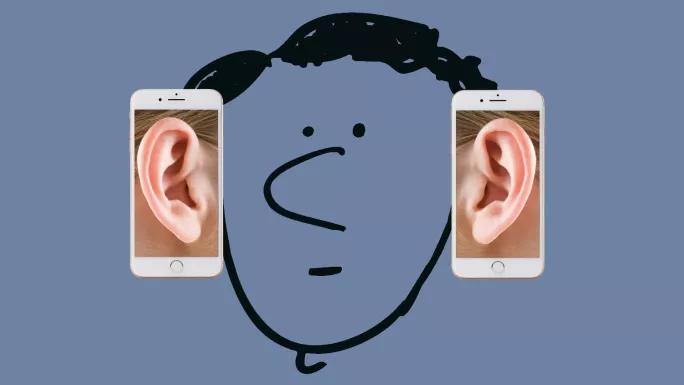
- Home
- Teaching the art of listening in the age of me, me me
Teaching the art of listening in the age of me, me me

Stephen Covey, in his book The 7 Habits of Highly Successful People, observes that “most people do not listen with the intent to understand. They listen with the intent to reply.” This observation has perhaps never been truer than it is today.
Debate so often involves polarised opinions: one side shouts their view across a yawning void at the other side, who are busy preparing another salvo in return.
There seem to be precious few who seek to hear in the words of those who oppose them a moment of insight that might explain why they think as they do, or an opportunity for common ground, or a cause to modify their own opinion. There seem to be few who say: “I have not yet made up my mind. I am still listening to the arguments.”
Instead, we decide quickly and dig in our heels. We presume those who disagree do so because they fail a test of character. We listen to reply, if we listen at all.
And, no, I do not suggest that I am immune from doing this.
A new way of thinking
This approach has plenty of causes: social media, the fragmentation of news sources, the tensions of rapid social change. Others are better qualified to explain it than me.
But if it is true of society that the game seems to be to shout loudest and listen least, we should ask ourselves whether this might be something we could address, mitigate or remediate in the way we run our classrooms.

In fact, we should go even further and ask whether the possibility exists that our classrooms unwittingly contribute to a culture that places insufficient value on listening, compromise and understanding, and which tells students that the purpose of participating in a discussion is to win it - for them to be proven to have been right all along.
Let me take you to a classroom here in the US, where I recently sat and listened to a discussion. It was, I think, successful from the teacher’s perspective, but I did not recognise it as a discussion.
There was lots of participation. And there were strong feelings. But what occurred were a series of opinions expressed aloud in turn. Students announced their own perspectives, arms crossed, and with a final nod on the last point. The kids were very engaged, so the teacher was happy.
I am often struck by how many teachers implicitly (or explicitly) equate participation in a discussion with talking: the more you talk, the more you’re contributing.
Just as often, teachers give implicit bonus points for ardent opinions. Feel it strongly and say it out loud, and you are furthering the discussion. The stronger the opinion, the better. The more you talk, the better.
But if talking - ardent talking in particular - is the primary definition of participation in a discussion, it raises the question of who is listening and whether a series of opinions spoken aloud in a room is a discussion at all.
Let me posit an alternative definition. A discussion should be a shared endeavour with the purpose of reaching greater mutual understanding of a topic and its complexity. The goal of the participants should be to hear other ideas and consider them; perhaps to bring nuance, depth or balance to their original point of view by considering the positions and insights of others.
Does that happen in most class discussions? I would argue not.
In teachers’ defence, discussions have some logistical challenges. As I have suggested, talking, which is easy to measure and observe, does not imply listening, which is harder to gauge. But it is easy to see why we implicitly prioritise the former over the latter: “You’ll be expected to participate at least five times throughout the marking period.”
So how do we get better listening and better discussion in our classrooms?
1. Get students writing
Writing is a key part of the solution. In fact, it is the single most important tool for discussion - a statement that might sound counter-intuitive. Getting students to write responses to a discussion question means every person involved will have an answer. This, of course, holds everyone accountable to respond. After all, some pupils need to speak up a little more in discussions. But some need to speak up a little less. Writing lets you manage the difference.
The power of writing to shape discussion goes even further. Because it is permanent, it can be a record of change over time.
So, imagine doing the following in your classroom: pose a question for discussion and ask every student to write an answer to the question. Now everyone is prepared. Seek out a strong and reflective response and ask the student to share it, to kick off the discussion. You can then circulate and encourage some students to weigh in because the response they wrote will further the discussion. That’s great for you and great to help them understand when their ideas are especially useful to share.
But the real value comes after the discussion, because the best post-discussion activity you can do is to say: “Now go back to your original response and revise it [or answer it again] based on the discussion we’ve just had.” In doing that, you have changed the purpose of the discussion. Where once the implicit goal might have been to win it - to be the person who was right all along - now your students’ goal is to find ideas they can use to develop and change their thinking.
If the question was about evaluating Napoleon’s decision to attack at Waterloo, perhaps they will have gleaned additional information to cite. If the question was about social justice, perhaps they might now use the perspective of someone else to revise their first thought.
As they do so, they create and make permanent for themselves and for you, the teacher, a record of that change. In fact, if you wanted, you could even double down on this post-discussion. You could say “OK, before we wrap up, I’d like to hear how some of you changed your opinions”, or even better: “Which comments from your peers most influenced you?”
This question gives an opportunity for public praise of the comments that students were most able to connect with, and thereby those that most influenced the perspectives of others. I suspect it won’t usually be the comments of the shouters that are chosen.
2. You should be writing, too
Consider the problem of remembering what others have said. Cognitive scientists often point out that we are all prisoners of short-term memory - we can keep precious little in our heads at any given time. Within a few seconds of engaging a thought, we begin to forget it. Striving to keep it in our working memory makes us unable to think and listen to other ideas. First we forget who said it and their exact phrasing. Soon the idea itself is gone.
Unless you are charting, that is. Charting is writing down shorthand versions of key points on the board during discussion. This keeps them alive.
As the teacher, I can glance at the board and recall the gist of what Chris or Christina said. I can refer back to it, build off it, develop it. Students can do the same.
It may sound simplistic, but one reason participants in large discussions don’t build off - and refer to - one another’s ideas is that they cannot remember them fully or retain them in short-term memory while thinking of their own idea. Charting helps overcome that and builds a strong incentive to respond to, and engage with, the ideas of others in the room.
Of course, it’s even better if students are charting, too. Not only does this teach them to take notes, but it socialises them to listen for - and expect - value in what their peers say.
Some of the best teachers I know at leading discussion always make sure students have place and time to take notes on what their peers have said.
3. Create response habits
Another useful tool for encouraging listening is “habits of discussion”. This involves
helping students to practise using phrases during discussion that help them build off one another, such as, “I’d like to develop Marcus’ point that…” or “I hear you, Andrea, but I also think there’s another way to interpret that quote…”
This is critical to giving pupils an alternative to seeing the world as my-way-or-the-highway. It’s a replacement behaviour for arguing simplistically.

4. Introduce tracking
This one is a bit controversial: tracking - the idea of making it a habit to “track the speaker”. That is, to turn and look at them while they are talking.
One of the things that happens when students track the speaker is they say with their body language, “I am listening. Your ideas matter.”
Neither you nor I would make honest or intellectually risky comments in a meeting if we did not feel those same sentiments from our peers. Students are not much different. Tracking helps students feel like their words will be respected.
But what’s more, it helps student listeners pay attention. They learn what it means to be attentive, to actively listen.
5. Make the aim clear
Again, this is a simple but important point. When you engage a discussion question, make it specific and write it on the board. This offers a constant and subtle reminder of the topic. For example, our discussion is not just an opportunity to say any old thing we want to say about this chapter in The Giver - we are discussing whether Jonas’ father is morally culpable for his role in “releasing” children.
This allows us to stay on topic. If you get a comment that’s unproductively off topic, you can simply point to the topic and say, “Thanks for that, but let’s try to stay a bit more focused on this question.” Or you could steer the discussion in more productive directions by saying something such as “remember the question hinges on the word ‘culpable’”, and perhaps then underline that word to help students focus on it for a sustained period of time.
By keeping your students focused on a collective purpose, you send the message that we are working together to come to an understanding of an idea. We are not just all of us expressing ourselves. We are engaged in shared inquiry.
Of course, it’s unfair to say that our classrooms are responsible for the fractious times we live in. But it’s also unfair to our students not to acknowledge the ways in which our classrooms might make things better. What we communicate about discussions, while we are having them, is a great way to start that process
Doug Lemov is a teacher trainer and the author of Teach Like a Champion, Teach Like a Champion 2.0 and Reading Reconsidered. He tweets @Doug_Lemov
Register with Tes and you can read five free articles every month, plus you'll have access to our range of award-winning newsletters.
Keep reading for just £4.90 per month
You've reached your limit of free articles this month. Subscribe for £4.90 per month for three months and get:
- Unlimited access to all Tes magazine content
- Exclusive subscriber-only stories
- Award-winning email newsletters
You've reached your limit of free articles this month. Subscribe for £4.90 per month for three months and get:
- Unlimited access to all Tes magazine content
- Exclusive subscriber-only stories
- Award-winning email newsletters



